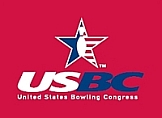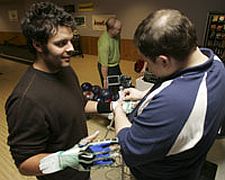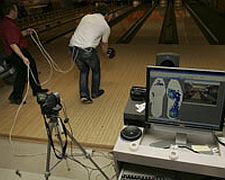Ridenour Biomechanics
Grip and foot pressure systems expected to have big impact on coaching, pro shops
Measuring pressure on specific points of the human body is becoming a new and growing focus for bowling coaching and training. The United States Bowling Congress has now developed advanced technology that can measure grip and foot pressure to improve the collection of motion data throughout a bowler's approach.
These patent-pending biomechanics systems, which transmit body movement data to a computer via a series of pressure sensors connected to a bowler's throwing hand and feet, are examples of new technology that USBC believes will usher in the future of coaching in the sport of bowling.
"This is the kind of technology we need in the sport of bowling," said USBC Research Engineer Paul Ridenour, who was instrumental in developing the grip and foot pressure systems.
"These systems work together with coaching. USBC hopes that by understanding biomechanics and applying these systems to the sport of bowling, we can give our coaches the most advanced tools to analyze bowlers and help teach athletes of all ability levels."
The grip pressure system measures the location and amount of pressure a bowler imparts on different parts of the throwing hand as it grips a bowling ball throughout an approach and delivery.
A bowler's hand is outfitted with a specially-designed sports glove with small pressure sensors (0.07 inches thick) attached by medical tape.
The sensors, which are made up of tiny, individual sensing units, transmit pressure data from the hand through a data hub worn on the wrist which is connected to a computer. Once a shot is recorded through the system, the data is analyzed on a computer.
World-renowned bowler, USBC coach and USBC Youth spokesperson Jason Belmonte of Australia, right, tests a new patent-pending grip pressure system that was developed by USBC Research Engineer Paul Ridenour, right. Belmonte was at USBC Headquarters in Greendale, Wis., recently for an international coach training event.
"From a coaching perspective, the grip pressure system can provide coaches with valuable information about things such as a bowler's rev rate, if a bowler squeezes the ball in the back swing and how grip pressure changes when a bowler uses a different release," Ridenour said.
"Measuring grip pressure can allow coaches to develop effective methods of teaching athletes different releases. From a ball driller's point of view, this can help to learn drillings that minimize a bowler's grip pressure."
The foot pressure system measures the location and amount of pressure placed on various parts of a bowler's feet during the approach and slide.
Pads with the same type of sensors used in the grip pressure system are placed underneath a bowler's shoe insoles. As a bowler makes an approach, foot pressure is measured and the data transmitted through hubs worn around the ankles to a computer and then analyzed. Sensors are calibrated based on a bowler's weight.
World-renowned bowler, USBC coach and USBC Youth spokesperson Jason Belmonte of Australia, right, tests a new patent-pending grip pressure system that was developed by USBC Research Engineer Paul Ridenour, right. Belmonte was at USBC Headquarters in Greendale, Wis., recently for an international coach training event.
"Foot pressure provides coaches with important data about a bowler's tempo, consistency of the approach, timing, power step, the slide and posting a shot," Ridenour said.
"Foot timing is one of the critical aspects of a bowler's physical game, and we can actually measure within one hundredth of a second the amount of time a bowler takes on a single step and how long a bowler will stay posted in the finish position. Both grip and foot pressure measurement can be synchronized with video footage of bowling students."
USBC plans for this and other new technology to be integral features of its planned 12-to-16-lane combined equipment testing and international training center in Arlington, Texas, if a deal is finalized, as expected, to move the headquarters of the sport's national governing body from Greendale, Wis.
In addition to grip and foot pressure systems, USBC is applying for a patent on another new technology system. These new technologies will be the subject of newly-named USBC Vice President - National Governing Body Neil Stremmel's seminars May 7-8 at the USBC Convention in Kansas City, Mo., and June 24 at International Bowl Expo in Orlando, Fla.
References
Article is courtesy of the USBC.



